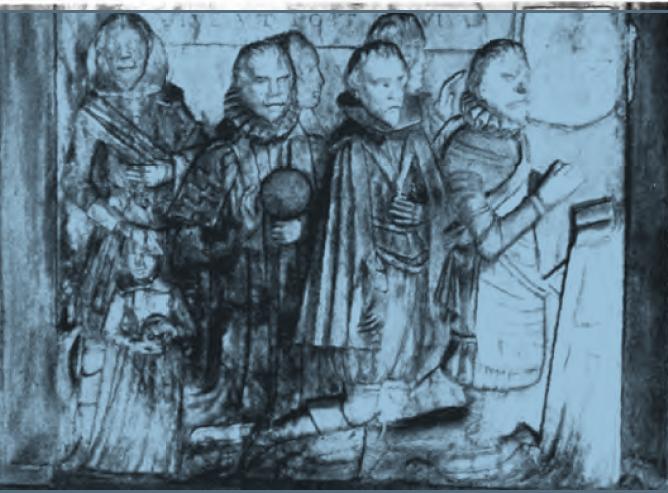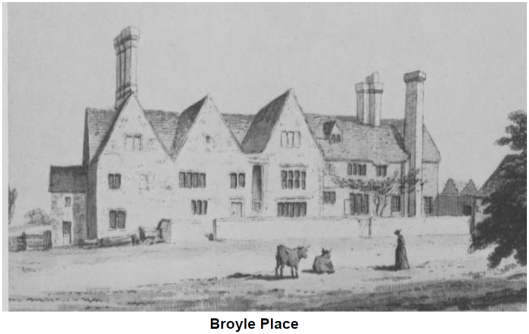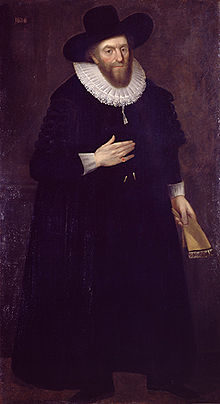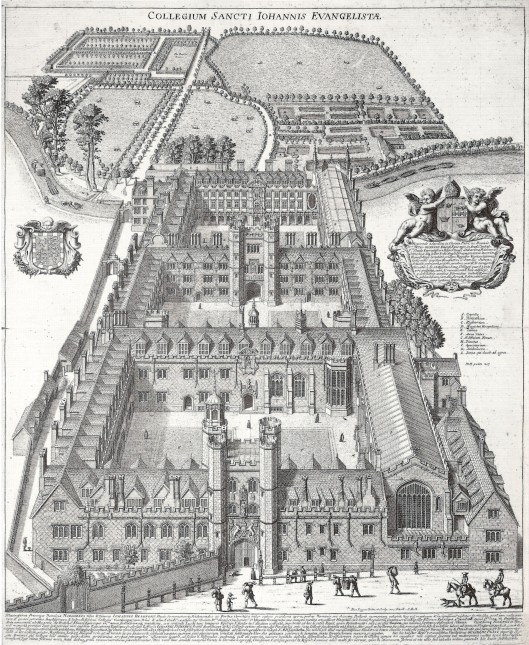(A version of this post first appeared on my family history site, Past Lives)
My exploration of Elizabethan and Jacobean recusancy begins with a network of families, tangentially connected to my own ancestors, living in Kent and Sussex in the late sixteenth and early seventeenth centuries. My interest in the Langworths, the family at the centre of this network, was sparked by an email from Emily Buffey, a doctoral researcher in English Literature at Birmingham University. Emily is researching the early modern dream vision, c. 1540 – 1625, and the focus of one of her thesis chapters is Thomas Andrewe, a minor poet of the period. Andrewe dedicated his 1604 poem ‘The Unmasking of a Feminine Machiavell’ (1604) to Dr John Langworth and Mistress Judith Hawkins. John Langworth, a cleric and something of a poet himself, was the brother of Arthur Langworth of Sussex; John’s daughter Mary married Richard Hawkins, from a notable Kent recusant family.
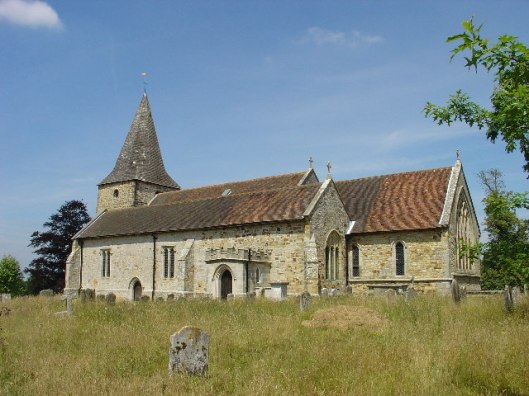
Parish church of St Margaret, Buxted, in Sussex, where Dr John Langworth was rector in the 1570s (via familysearch.org)
Emily contacted me because Arthur Langworth’s name occurs in the will of my 12 x great grandfather, Magnus Fowle of Mayfield, Sussex, who died in 1595. Here is the relevant passage from Magnus’ will:
Item I give to everye of my servants who are in my house Tenne shillings provided always and my verie will and mynde is That and yf my sonne Edward Byne or my daughter his wiefe or Magnus Byne shall att any tyme entrust bargayne sell alienate lease demyse grante or otherwise convey or assine any of my Landes Tenements rents or herydtaments situate or lyinge in Ringmer or Glynde of the saide countie of Sussex to Arthur Langworth to his heires or to anie of his name, or to anie other p[er]sone or p[er]sones whereby or by meanes whereof anie of my saide Landes or the inhertytance thereof maie come to the saide Arthure or to anie other p[er]sone or p[er]sones to his use, or to the use of anie of his heries or of his name, Then my verie will and mynde is that John Motley gentleman John Fitzherbert, John Corneforde, nowe of Grensted John Shepparde sonne of Robert Shepparde deceased, John Delve and Thomas Sharpe and their heires shall have full power and authorytie to enter into all my purchased Landes and Tenementes and the same to reteyne to them and their heires to the use of the poore of the parish of Ringmer, the Towne of Lewes and Southover, and the parrishe of Retherfield.
I’m intrigued by the intensity of Magnus Fowle’s hostility to Arthur Langworth, and I’m keen to discover its root cause. At the same time, I remain fascinated by Magnus’ religious affiliation. His father Gabriel seems to have remained loyal to the Catholic faith through the religious turbulence of the mid-sixteenth century, while Magnus’ will bequeaths money to members of another famous recusant family, the Ashburnhams, even though Magnus himself appears to have conformed, at least outwardly, to the newly-protestant Church of England. The recusant associations of the Langworths, as well as their link (albeit a hostile one) to my ancestor, have prompted to me to dig deeper into their background and their connection to a network of families with similar sympathies.
According to a number of sources, Arthur and John Langworth were the sons of Lancelot Langworth of ‘Kertlebury’, Worcestershire, and there was a third brother named Adam. The Langworth pedigree in the record of the 1619 Visitation of Kent claims that their mother’s maiden name was Gore and that she was from the same county. Kertlebury doesn’t exist on any extant map of Worcestershire and it’s possible that it’s a mistake for, or an archaic form of, Hartlebury, a village five miles south of Kidderminster. I’ve found records for the births of Arthur and Adam Langworth in Chaddesley Corbett, four miles east of Hartlebury, in 1548 and 1551 respectively. However, the name of their father is said to be Thomas, not Lancelot. Thomas Langworth also had a daughter named Ann christened in the same parish in 1547. Isabel Langworth, whose father’s name is not given, had been baptised there in 1543. In 1544 a John Langworth, whose father’s name was Richard, was christened in Chaddesley Corbett, and in the following year another John Langworth, father’s name unknown, was also born there.
At this stage, it’s not possible to resolve this puzzle about the origins of the Langworth brothers. However, it seems likely that they had at least one sister, since the poet Thomas Andrewe describes John Langworth as his uncle. Of course it’s possible, as Emily suggests, that the word ‘uncle’ is being used loosely, as we know that ‘cousin’ was in other documents of this period, or that Thomas was John Langworth’s ‘nephew’ by marriage, for example to one of his John’s nieces. So far, my research into the Langworths hasn’t been able to determine exactly how Thomas Andrewe fits into the family tree.
Arthur Langworth
Arthur Langworth appears to have been the eldest of the three brothers, and therefore the heir to his father’s estate. This probably explains why, unlike his two younger brothers, he seems not to have been sent to university. It’s unclear at what point the family moved south, since later records find them in Sussex and Kent. We know that Arthur Langworth married in the Midlands – at Halford in Warwickshire (forty-five miles or so from Hartlebury) to be precise – on 10th September 1571, when he was probably in his mid-twenties. His wife was Rose Durant, daughter of William Durant of the manor of Cottesmore, Rutland and his second wife Margaret Sherrard.
Certainly Arthur and Rose Langworth’s children were all born (or at least baptised) in Sussex. Their son Adam was christened at Ringmer on 30th June 1577, but all the other children for whom we have records were baptised at Buxted, some twelve miles to the north: Richard on 11th January 1578; Rose on 17th March 1580; and Arthur on 19th December 1585. The Sussex visitations document also mentions two other sons, John (his eldest and the heir to his estate) and Nicholas, and another daughter named Jane. In addition, Arthur Langworth’s will mentions a son called Edward and a daughter Agnes.
A number of sources confirm that Arthur Langworth and his family lived at The Broyle, a large estate close to Ringmer, which included a deer park. One source has the Langworths living at Broyle Place, a house within the park. The same source states that Arthur also owned lands at Laughton and Little Horsted, but that he died at Blackfriars, London.
The Langworths appear to have had a continuing association with Blackfriars. Arthur’s daughter Rose was married at the church of St Ann, Blackfriars on 22nd December 1607, to William Lovell or Lowell. One pedigree claims he was the brother of Sir Francis Lovell. A number of sources state that Arthur’s eldest son John, who inherited the Broyle from his father, married Mary Challoner, the daughter of Thomas Challoner of Lindfield, Sussex. However, in his will John gives his wife’s name as Barbara. There is a record of a John Langworth marrying a Barbara Challoner at St Ann, Blackfriars, shortly before his death, on 25th May 1612 (oddly, John made his will in the previous year). Perhaps Mary died and John married one of her relatives, perhaps a sister?
There are a number of references to Arthur Langworth in the diary of the theatrical entrepreneur Philip Henslowe, who was originally from Sussex, and whose father had been master of the game at the Broyle. (Henslowe appears as a character in the 1998 film Shakespeare in Love, played by Geoffrey Rush.) Langworth seems to have been involved in a number of property deals with Henslowe, and with his son-in-law, the actor and theatrical manager Edward Alleyn. Langworth’s will mentions a debt owed to him by Alleyn.
On page 157 of Henslowe’s diary we find the following:
mrdm [memorandum] that mr. arture Langworth hath promised the 16. daye of maye 1595 to paye vnto me phillippe Henslowe the some of j undreth pownde ffor a howsee & land [wch] & goode wth he bargained wth me wth owt any condicion but absolutely to paye me so mvche mony & to tacke such a surence as J haue at this time witneses to this promes of payement
And on page 194:
Sowld vnto mr Arthur langworth the howsee wch my brother dwelte in after the deseace of my syster Margery his wife wth the trash ether in for the some of… iiij score pownde wittnes E Alleyn J saye…
The detailed index of persons attached to a modern edition of the diary provides a full list of Arthur Langworth’s business dealings with Philip Henslowe. Many of them involve Henslowe borrowing money from Langworth, but others relate to the sale of parsonages. For example, there is mention of deal between Langworth and Alleyn involving the parsonage of Firle near Ringmer. Relations between Langworth and Alleyn were obviously cordial, since we read that on 4th June 1598 Edward Alleyn was staying with Arthur and Rose Langworth at the Broyle. There is no suggestion in any of these records that Arthur Langworth’s business dealing were at all improper. However, I wonder if Magnus Fowle’s hostility to Langworth might be the legacy of a property deal between the two men that went sour?
Arthur Langworth’s will of 1606 appoints his wife Rose and son Richard as co-executors and his brother John Langworth as overseer. His son-in-law William Lovell was one of the witnesses. Arthur’s eldest son John outlived his father by only six years, dying at Ringmer in 1612, and apparently leaving nine children, of whom his son John (presumably the eldest) is the only one to be named in his will. Also mentioned in the will, and one of its witnesses, is Sir Henry Compton, who sat in Parliament for East Grinstead.
Adam Langworth
Arthur Langworth’s younger brother Adam matriculated at St John’s College, Cambridge, in the Michaelmas term of 1566, which means he was probably born in about 1550. He was said to be ‘of Worcestershire’. He graduated B.A. from Queens’ College in 1569-70 and M.A. from Corpus Christi in 1573, where he had been a Fellow for two years. Afterwards he was a Fellow of St Catharine’s. I don’t know enough about the universities in the sixteenth century to understand the meaning of these appointments, or the significance of Adam’s choice of colleges, or his movement between them. (Some seventy years later, Edmund Byne, a minister of distinctly Puritan sympathies, and the brother of my 9 x great grandfather Magnus Byne, would move between Peterhouse, Trinity and Gonville and Caius Colleges at Cambridge.)
One pedigree states that Adam was married to a woman with the surname Syms, but I’ve yet to find a record of their marriage. Judging by the birth dates of their children, I would hazard a guess that it took place in the early 1580s, after Adam left Cambridge. For some reason, this Cambridge Fellow decided to follow his older brother Arthur to Buxted in Sussex, where his daughter Elizabeth was born and christened on 29th June 1586. Another daughter, Sybill, followed on 30th December 1588 and a son Thomas on 3rd May 1590.
At some point in the next three years, Adam moved his family to Canterbury, perhaps because his brother John had been given a clerical appointment at the Cathedral. On 28th October 1593 a daughter named Dorothy was baptised there at the church of St George the Martyr, and on 27th January 1604 another daughter named Pelludia was christened in the cathedral. Adam’s first daughter Elizabeth must have died young, as another daughter with the same name was christened at Canterbury Cathedral on 22nd November 1607.
Adam Langworth died in Canterbury in 1622. His will of 1620 mentions his son Thomas and three other sons, Anthony, John and Francis, for whom I’ve yet to find baptismal records. Adam also mentions Elizabeth, whom he describes as his youngest daughter. The will also refers to three married daughters: Sybill and Dorothy, mentioned above, and also Ann.
Dorothy appears to have been married to the John Colman mentioned in the will, since her sons are referred to as Henry, Adam and John Colman. John Colman and Dorothy Langworth had been married on 16th April 1612 at the church of St Mary Bredin in Canterbury. The Colman family were from the village of Petham, about four miles south of Canterbury. In addition to Henry, Adam and John, John and Dorothy Colman had three other sons: Thomas, Benjamin and Nathaniel. I’ve only found a christening record for the last-named, on 20th October 1633 at St Mary Abchurch in London: Adam Longworth’s will suggests that the Colmans owned a house in Cannon Street.
Dorothy’s sister Sybill married Henry Colman, who I believe was John’s brother. I have a note that the ceremony took place in Petham on 17th April 1609, but I can’t locate the source for this. A third son-in-law, Robert Fleming, is named in Adam Langworth’s will, and he appears to have been married to Ann, but I’ve yet to find any firm evidence of this.
In his will Adam Langworth bequeaths to his sons Anthony and John his lease of the manor of Elverland in the village of Ospringe about twelve miles to the west of Canterbury, which he held from the master, fellows and scholars of St John’s, Cambridge, his old college. His son Francis is bequeathed property that Adam leased from the dean and chapter of Christ Church, Canterbury. His eldest son Thomas is appointed as Adam’s sole executor.
Dr John Langworth
John Langworth was born in 1547. He matriculated at St John’s College, Cambridge in 1566, the same year as his brother Adam, but in the previous (Easter) term. He graduated B.A. in 1567-8, M.A. 1572 and B.D. (Bachelor of Divinity) in 1577-8. John was a Fellow of St John’s in 1568. At some point he moved to Oxford University where he was incorporated in 1572 and graduated D.D. (Doctor of Divinity) in 1579. At Oxford John attended Hart Hall, the forerunner of present-day Hertford College, about which Wikipedia has this to say:
In the latter half of the 16th century, Hart Hall became known as a refuge for Catholic recusants, particularly under Philip Randell as Principal (1548–1599). Because of its connection with Exeter College and that college’s increasing puritanism, a number of Exeter’s tutors and scholars migrated to Hart Hall. The hall attracted an increasing number of Catholics from further afield, including the Jesuit tutor Richard Holtby in 1574, who was instrumental in the conversion of his student, and later Jesuit martyr and saint, Alexander Briant to Catholicism. Coming from a Catholic family, the English poet John Donne came up to Hart Hall in 1584.
John Langworth conformed, at least outwardly, to the protestant Church of England, rising to high office in the Church, but one source describes him as a ‘church papist’ and, as we shall see, at least two of his children married into Catholic families. John’s first clerical appointment was as Prebendary of Worcester in 1568, before he moved, like his brothers, to Sussex, where he was Rector of Folkington in 1573 and of Buxted in 1574 (these appointments would have run concurrently with his time at Oxford University). It’s possible, of course, that John baptised a number of his nephews and nieces, the sons and daughters of his brothers Arthur and Adam, during his time at Buxted. John Langworth was appointed as a University preacher at Oxford in 1577. He was Archdeacon of Chichester between 1581 and 1586 and then Archdeacon of Wells in Somerset between 1589 and 1609, before returning to Sussex as rector of Rotherfield in 1592. At some point John moved to Canterbury, where he was Prebendary until his death in 1614.
According to the records of the Visitation of Kent, 1619, John Langworth married Frances Finch, daughter of John Finch of the manor of Sandhurst in Faversham, ten miles to the west of Canterbury and close to Adam Langworth’s property at Ospringe.
In 1602 John Langworth, who was then of Buxted, purchased the manor of Sompting Peverell in Sussex from Thomas Pelham and in 1611 settled it on his fourth son, Anthony. One source describes John Langworth as being ‘of Wilmington’, a parish some distance from Canterbury, near Dartford, and this is certainly where his son Francis would later live. The Kent Visitation of 1619 records that John and Frances Langworth had five children: Thomas, Mary, Anna, Helena and Martha. However, another source adds Arthur, John and Anthony to this list.
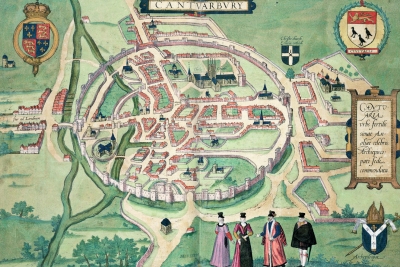
16th century street plan of Canterbury (via http://www.spab.org.uk)
John Langworth was the author of a number of religious sonnets, which were published in a contemporary miscellany by John Lilliat, a cathedral musician at Wells, together with poems by better-known figures such as John Davies, George Gascoigne and Christopher Marlowe. I’m grateful to Emily Buffey for sending me a copy of Langworth’s poems, which I’ll perhaps discuss in more detail on another occasion.
John Langworth died in 1613 and was buried in Canterbury Cathedral on 13th January, 1613-4. His daughter Mary married Richard Hawkins, who had been born in 1581. He was the son of Sir Thomas Hawkins (1548 – 1617) of Nash Court in Boughton under Blean, a few miles to the west of Canterbury, and Ann (1552 – 1616), daughter of Cyriac Pettyt and his wife Florence, also of Boughton. Both the Hawkins and the Petits were recusant families. Richard Hawkins’ brother Henry (1577 – 1646) was a Jesuit priest and author, and another brother, Sir Thomas Hawkins (1575 – c.1640) was a translator of recusant books. Other surviving brothers were Daniel (b. 1578), John, a physician and author, and Cyriac. Richard’s sister Susanna (b. 1580) married the recusant John Finch of Grovehurst, Milton near Sittingbourne (was he any relation of John Langworth’s father-in-law, John Finch of Faversham?); another sister Anna married William Hildesley of Oxfordshire; and two other sisters, Bennet (b. 1586) and Benedicta (1588–1661), became Benedictine nuns in Brussels (though one source implies that these might be alternate names for the same sister).
Another of John’s daughters, Helena (also known as Helen or Eleanor), also appears to have married into a Catholic family – or rather, a family with definite Catholic sympathies. On 21st October 1611 she married Nathaniel Spurrett at the church of St Botolph, Aldgate, in London. Nathaniel seems to have been a haberdasher. He was the son of Anthony Spurrett, the rector of Wolford and vicar of Icomb in Gloucestershire and formerly sizar at St John’s College, Cambridge. Nathaniel died only a year after his marriage to Helena, at the age of 33, and shortly after the birth of their daughter Frances. Helena died at Eltham, Kent, in 1626. After her parents’ death, their orphaned daughter was taken in by an order of English Franciscan nuns: she was clothed at the age of 15, and professed at 16. The order was based in Belgium, where Sister Frances Evangelist died in 1635 at the age of 23.
John Langworth’s son Francis was born in about 1598 and followed him to Hart Hall, Oxford, matriculating on 31st October 1617. The list of Oxford alumni states that he was of Wilmington, Kent and that his father John lived at Ospringe, which was where we know John’s brother Adam owned property (see above). Francis was a student at Gray’s Inn in 1620. In 1628 he married Mary Tucker, the daughter of George Tucker of Milton near Gravesend, Kent, and his wife Mary, daughter of John Darrell of Calehill. The wedding took place at Little Chart near Ashford, close to the ancestral home of the Darells at Calehill. It seems that the Darells were yet another recusant family, and were probably relate to the Darells of Scotney Castle, Lamberhurst, about whom I wrote here. Francis and Mary Langworth had four children: Daniel, Francis, George and Elizabeth.
In future posts, I’ll be discussing what became of John Langworth’s children, and exploring their links by marriage with a number of important recusant families.
